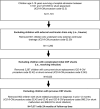Infection rates following initial cerebrospinal fluid shunt placement across pediatric hospitals in the United States. Clinical article
- PMID: 19645551
- PMCID: PMC2896258
- DOI: 10.3171/2009.3.PEDS08215
Infection rates following initial cerebrospinal fluid shunt placement across pediatric hospitals in the United States. Clinical article
Abstract
Object: Reported rates of CSF shunt infection vary widely across studies. The study objective was to determine the CSF shunt infection rates after initial shunt placement at multiple US pediatric hospitals. The authors hypothesized that infection rates between hospitals would vary widely even after adjustment for patient, hospital, and surgeon factors.
Methods: This retrospective cohort study included children 0-18 years of age with uncomplicated initial CSF shunt placement performed between January 1, 2001, and December 31, 2005, and recorded in the Pediatric Health Information System (PHIS) longitudinal administrative database from 41 children's hospitals. For each child with 24 months of follow-up, subsequent CSF shunt infections and procedures were determined.
Results: The PHIS database included 7071 children with uncomplicated initial CSF shunt placement during this time period. During the 24 months of follow-up, these patients had a total of 825 shunt infections and 4434 subsequent shunt procedures. Overall unadjusted 24-month CSF shunt infection rates were 11.7% per patient and 7.2% per procedure. Unadjusted 24-month cumulative incidence rates for each hospital ranged from 4.1 to 20.5% per patient and 2.5-12.3% per procedure. Factors significantly associated with infection (p < 0.05) included young age, female sex, African-American race, public insurance, etiology of intraventricular hemorrhage, respiratory complex chronic condition, subsequent revision procedures, hospital volume, and surgeon case volume. Malignant lesions and trauma as etiologies were protective. Infection rates for each hospital adjusted for these factors decreased to 8.8-12.8% per patient and 1.4-5.3% per procedure.
Conclusions: Infections developed in > 11% of children who underwent uncomplicated initial CSF shunt placements within 24 months. Patient, hospital, and surgeon factors contributed somewhat to the wide variation in CSF shunt infection rates across hospitals. Additional factors may contribute to variation in CSF shunt infection rates between centers, but further study is needed. Benchmarking and future prospective multicenter studies of CSF shunt infection will need to incorporate these and other patient, hospital, and surgeon factors.
Figures



Similar articles
-
Antibiotic impregnated catheters and intrathecal antibiotics for CSF shunt infection prevention in children undergoing low-risk CSF shunt surgery.BMC Pediatr. 2024 May 11;24(1):325. doi: 10.1186/s12887-024-04798-9. BMC Pediatr. 2024. PMID: 38734598 Free PMC article.
-
Reinfection following initial cerebrospinal fluid shunt infection.J Neurosurg Pediatr. 2010 Sep;6(3):277-85. doi: 10.3171/2010.5.PEDS09457. J Neurosurg Pediatr. 2010. PMID: 20809713 Free PMC article.
-
Postoperative cerebrospinal fluid wound leakage as a predictor of shunt infection: a prospective analysis of 205 cases. Clinical article.J Neurosurg Pediatr. 2009 Aug;4(2):166-9. doi: 10.3171/2009.3.PEDS08458. J Neurosurg Pediatr. 2009. PMID: 19645552
-
Association of intraventricular hemorrhage secondary to prematurity with cerebrospinal fluid shunt surgery in the first year following initial shunt placement.J Neurosurg Pediatr. 2012 Jan;9(1):54-63. doi: 10.3171/2011.10.PEDS11307. J Neurosurg Pediatr. 2012. PMID: 22208322 Free PMC article.
-
Progression of cerebrospinal fluid cell count and differential over a treatment course of shunt infection.J Neurosurg Pediatr. 2011 Dec;8(6):613-9. doi: 10.3171/2011.8.PEDS11236. J Neurosurg Pediatr. 2011. PMID: 22132920 Review.
Cited by
-
Ceftaroline Cerebrospinal Fluid Penetration in the Treatment of a Ventriculopleural Shunt Infection: A Case Report.J Pediatr Pharmacol Ther. 2020;25(4):336-339. doi: 10.5863/1551-6776-25.4.336. J Pediatr Pharmacol Ther. 2020. PMID: 32461749 Free PMC article.
-
Molecular Characterization of Microbiota in Cerebrospinal Fluid From Patients With CSF Shunt Infections Using Whole Genome Amplification Followed by Shotgun Sequencing.Front Cell Infect Microbiol. 2021 Aug 20;11:699506. doi: 10.3389/fcimb.2021.699506. eCollection 2021. Front Cell Infect Microbiol. 2021. PMID: 34490140 Free PMC article.
-
Revision surgeries are associated with significant increased risk of subsequent cerebrospinal fluid shunt infection.Pediatr Infect Dis J. 2012 Jun;31(6):551-6. doi: 10.1097/INF.0b013e31824da5bd. Pediatr Infect Dis J. 2012. PMID: 22333701 Free PMC article.
-
Prevalence and nature of adverse medical device events in hospitalized children.J Hosp Med. 2013 Jul;8(7):390-3. doi: 10.1002/jhm.2058. Epub 2013 Jun 7. J Hosp Med. 2013. PMID: 23744814 Free PMC article. Review.
-
The effects of socioeconomic status and race on pediatric neurosurgical shunting.Childs Nerv Syst. 2014 Jan;30(1):117-22. doi: 10.1007/s00381-013-2206-5. Epub 2013 Jun 30. Childs Nerv Syst. 2014. PMID: 23811830
References
-
- Albert JE, Simon TD, Hall M, Kestle J, Jeffries HE. Improved identification of pediatric neurosurgical procedure infections. E-PAS2008. 2008;62:3792.6. (Abstract)
-
- Albright AL, Pollack IF, Adelson PD, Solat JJ. Outcome data and analysis in pediatric neurosurgery. Neurosurgery. 1999;45:101–106. - PubMed
-
- Amacher AL, Wellington J. Infantile hydrocephalus: long-term results of surgical therapy. Childs Brain. 1984;11:217–229. - PubMed
-
- Berry JG, Hall MA, Sharma V, Goumnerova L, Slonim AD, Shah SS. A multi-institutional, 5-year analysis of initial and multiple ventricular shunt revisions in children. Neurosurgery. 2008;62:445–454. - PubMed
-
- Borgbjerg BM, Gjerris F, Albeck MJ, Borgesen SE. Risk of infection after cerebrospinal fluid shunt: an analysis of 884 first-time shunts. Acta Neurochir (Wien) 1995;136:1–7. - PubMed
Publication types
MeSH terms
Grants and funding
LinkOut - more resources
Full Text Sources
Other Literature Sources
Medical

